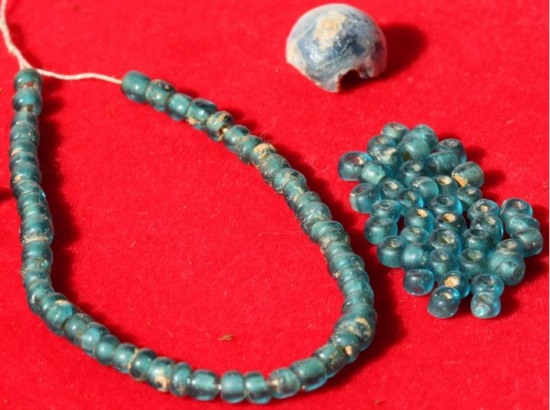Hirohiko Nakamura
Source - http://ajw.asahi.com/article/behind_news/social_affairs/AJ201401170006

A glass ball and beads unearthed at the Takamatsuzuka tomb in Asuka, Nara Prefecture (Asahi Shimbun file photo)
Advances in chemical analysis are helping archaeologists to gain a better understanding of what early inhabitants of the Japanese islands were like.
In recent years, new hypotheses have emerged from testing of artifacts and amino acids in human remains about the origins of ancient Japanese.
By blending conventional archaeological research with the latest advances in chemistry, scientists are slowly unraveling many of these mysteries.
A team led by Tokyo University of Science professor Izumi Nakai has developed a special X-ray fluorescence (XRF) analyzer for chemical analysis, which can detect different types of elements and their concentration.
Many decorative items, such as glass beads less than 1 centimeter in diameter, have been found in sites dating to Japan's Yayoi Pottery Culture (300 B.C.-A.D. 300) and in tumuli built during the Kofun Period (third century to seventh century).
Glass was not made in Japan at this time, which means the beads came from overseas. But from where is not known.
Unlike ordinary glass objects, it is difficult to speculate on the origins of simple glass beads based on their ornamentation or patterns. Nakai's team hopes to reveal the origin of ancient Japanese glass through chemical analysis.
The elemental composition of glass varies, depending on where it is made. Researchers can figure out where glass in ancient Japan was brought from by using an XRF analyzer to compare samples from Japan and elsewhere.
Nakai's team analyzed glass beads excavated from over 100 tumuli and archaeological sites across Japan, as well as cultural properties kept at Todaiji temple in Nara and Byodoin temple's Phoenix Hall in Kyoto Prefecture. They also examined artifacts from sites in Turkey and Syria as well as Laos, Vietnam and elsewhere.
Many beads excavated in western Japan are alumina soda-lime glass, which contains a large amount of aluminum. The results of the analysis showed that even the beads' trace components closely matched glass found at sites in India and Southeast Asia. Pigments used to color the glass were also of the same type and composition.
"We were able to scientifically prove a very high likelihood that ancient glass in Japan was carried from Southeast Asia and South Asia by maritime trade," Nakai said. "This shows us that ancient people used the maritime Silk Road in addition to the overland Silk Road to carry goods to and from West Asia."
FROM AMINO ACIDS
Research is also being done on the eating habits of ancient Japanese by analyzing amino acids taken from human remains and animals excavated at archaeological sites.
A University of Tokyo team led by Minoru Yoneda, a professor of isotope ecology, has focused on nitrogen inside amino acids. Through eating, nitrogen is absorbed into the body where it accumulates. The team believes it may be able to figure out eating habits by examining the proportion of nitrogen isotopes N15 and N14 extracted from bones.
Yoneda and his team extracted collagen protein from human and animal bones found at the Tochibara rock shelter, a site in Nagano Prefecture that dates to the Jomon Pottery Culture (8000 B.C.-300 B.C.).
In the samples extracted, the team examined the proportion of nitrogen isotopes in the amino acids phenylalanine and glutamic acid.
Yoneda said the size of the Tochibara rock shelter suggests that it likely housed a large number of people.
According to one theory, an enormous quantity of food was needed to feed the community. That could have marked the start of farming in the area because of uncertain supplies of food from hunting.
The results of an analysis of the amino acids showed a large divergence in the ratio of nitrogen isotopes between Margaritiferidae, a family of freshwater mussels and mollusks, on one side and humans and land animals on the other. The team said the results indicate that humans relied on land ecosystems for food.
Furthermore, the value of the isotopic ratio in humans is nearly the same as that for foxes, which are mainly carnivorous animals, rather than the figure found in largely herbivorous animals such as deer, rabbits and wild boar.
This demonstrates that while the humans were omnivorous, they principally consumed meat. The results allow the researchers to estimate that 50 to 70 percent of the protein consumed by humans came from land animals.
This finding caused Yoneda to express doubts about conventional theories.
"If they primarily lived as farmers, then the figure should be closer to those of herbivores," he said. "Perhaps agriculture had not developed yet in this region."